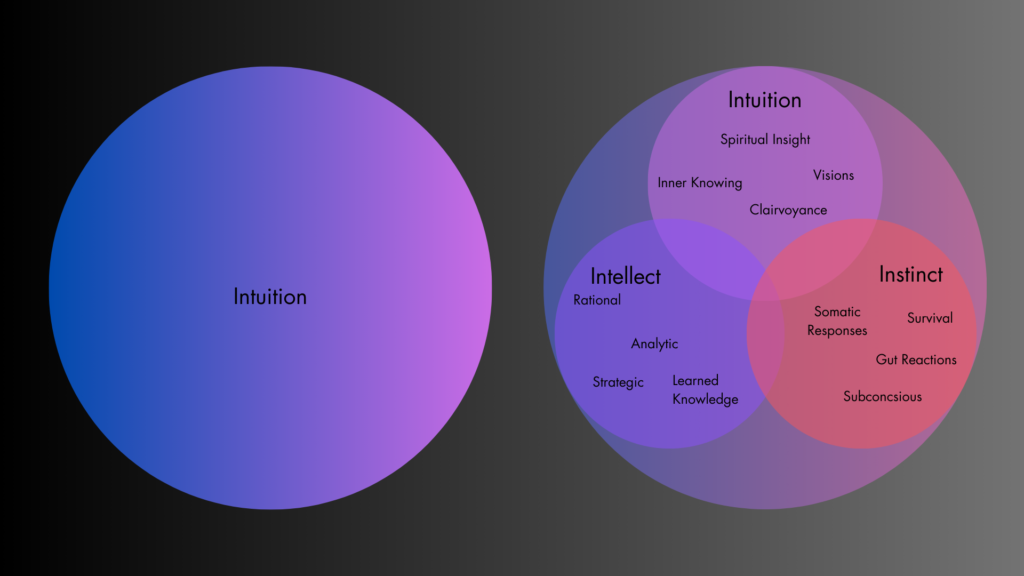In our journey towards self-discovery, a common obstacle we often encounter within the spiritual community is the challenge of distinguishing true intuition from anxiety or the instinctual “gut reaction.” These are expressions of the different vehicles within us that we use for decision-making and guidance. Although connected, they stem from different facets of our being.
The three vehicles—instinct, intellect, and intuition—serve unique functions, yet when misinterpreted as one, can lead to decisions that may not fully resonate with our true selves. The problem arises when these distinct vehicles are all mislabeled as intuition, leading us down paths that may not align with our highest potential.
To clarify this complexity, I’ve created a Venn Diagram that visually breaks down these three integral aspects of our psyche:

The image on the left represents how 99% of people perceive intuition—a singular, encompassing entity. However, the diagram on the right dissects this broad understanding into its appropriate components, showing how each contributes to our inner wisdom.
If you think about it, the majority of the population is not tapped into their inner knowing. So most of the things that people are using for decision making is not going to lead them to their highest self – which will be a harmonization of all 3 vehicles. the complete human being understands these 3 vehicles and knows how to use them properly in their decision-making.
If you think about it, most people aren’t fully tapped into their inner knowing, which means their decision-making often doesn’t guide them to their Highest Self. A harmonization of all three vehicles—instinct, intellect, and intuition—is what creates the complete human experience. Understanding and utilizing these vehicles effectively is key to making enlightened choices.
Let’s dive into the intersections of these vehicles as demonstrated in our diagram:
1. Instinct and Intellect (Adaptive Reactions)
- Description: This area represents the integration of primal responses with rational thought. When instinct and intellect overlap, they produce adaptive reactions that can be both quick and informed by past experiences and learned knowledge.
- Dynamic: For example, consider a scenario where you feel an immediate gut reaction to a potentially dangerous situation (instinct), and your intellect quickly evaluates this feeling based on past experiences and current observable facts to decide whether to flee or confront the situation. This overlap ensures that your responses are not just primal but also adapted to the complexities of modern circumstances.
2. Intellect and Intuition (Enlightened Thinking)
- Description: When intellect and intuition intersect, it facilitates a higher level of reasoning that incorporates not just logical analysis but also a deeper, often subconscious understanding.
- Dynamic: In professional or creative endeavors, this overlap can lead to breakthrough ideas and solutions. The intellect processes logical data and existing knowledge, while intuition contributes insights that are not immediately obvious or derived from direct reasoning, leading to innovative thinking and decision-making.
3. Instinct and Intuition (Natural Insight)
- Description: This intersection combines the primal, inherent knowledge of instinct with the spiritual and profound awareness of intuition.
- Dynamic: An example of this dynamic can be seen in parental instincts, where a parent may instinctively know when something is wrong with their child (instinct) and also feel a deeper, intuitive understanding of what the child needs beyond physical or obvious emotional cues (intuition). This blend results in an almost innate wisdom, guiding decisions that are deeply attuned to the well-being of others.
4. Full Spectrum Decision-Making (All Three Intersecting)
- Description: At the center where instinct, intellect, and intuition all overlap, decision-making becomes fully integrated, balancing immediate reactions, thoughtful analysis, and deep knowing.
- Dynamic: This holistic approach is most evident in critical life decisions, such as choosing a career path, making investment choices, or navigating complex personal relationships. Here, you simultaneously draw on your gut feelings (instinct), rational considerations (intellect), and a deeper sense of what feels right or destined (intuition), leading to choices that are well-rounded and deeply satisfying.
Why this Matters
Recognizing the three vehicles within us—instinct, intellect, and intuition—is vital for making life decisions that resonate with our truest selves. By achieving a balance among these three, decision-making becomes a process of ease, even when facing the most formidable choices. With this equilibrium, we gain clarity, understanding the implications of our actions and ensuring that each step we take is a stride towards our authentic self. These vehicles are universal tools, applicable in every facet of life, from professional endeavors to personal relationships.
We have always utilized these aspects of our consciousness, often without realizing their distinct influences. The journey ahead is about intentional use, steering these vehicles consciously, rather than being unconsciously driven by them.